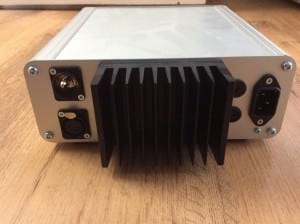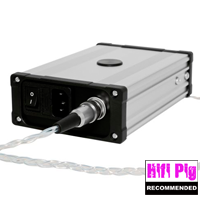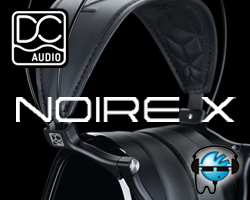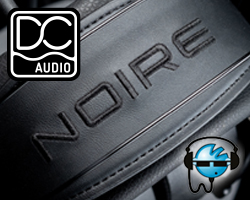Some time ago now I reviewed the Paul Hynes SR3 linear regulated power supply. At the time I had the equivalent in a Teddy Pardo PSU which I was using on a modified Squeezebox Touch. The PH supply was a wonderful edition and an upgrade from the Teddy Pardo, excelling in organic detail retrieval and natural dynamics.
modified Squeezebox Touch. The PH supply was a wonderful edition and an upgrade from the Teddy Pardo, excelling in organic detail retrieval and natural dynamics.
Since the review and the purchase of the SR3 I began to talk more with Paul and his business partner David Webb where we discussed the benefits of power supplies with even greater performance, their bespoke implementations and overall benefits. Subsequent to our conversations and me having my Mac Mini upgraded in various ways, Paul built me an SR5 power supply to replace the awfully noisy switch mode power supply that came as standard in the new Unibody Mac.
Before its completion and after doing some further research it seemed liked a confident adoption to the Macs extensive upgrades to have the SSD ran separately in a matching ‘mini stack’ case to match the Mac Mini’s main body. The unit would then connect via a galvanically isolated firewire cable and powered separately also.
This called for another supply and on Paul’s recommendations another SR5. This one would have twin 12v outputs and a total current output capability of 6 amps, capable of running the external OSX drive and the Airport Extreme router which connected the Mac to the NAS. The first was of the same specification power wise but had the ability to be switched from 12v to 5v on a single output as Paul wanted me to be able to compare the differences between the SR5 and the previous SR3 that I had powering the Squeezebox.
From a visual point of view the volumetric capacity of the SR5 is around four times greater than the SR3 and it weighs considerably more. This is somewhat due to the toroidal transformer which is installed in the SR5. A 160va bespoke custom made Toroid from the leading UK manufacturer, the tolerances are tight and the construction is extremely exact and to Paul’s specific requirements. The toroid is very quiet and avoids core saturation under heavier loads. The SR3 is 50va and is what Paul considers to be the very best ‘off the shelf’ toroid he could possible obtain.
The casework on the SR5 is very nice indeed with a nice aluminium front panel and a centred on/off switch. A blue LED shines downwards onto the shelf from underneath the front panel to indicate power and has no feedback into the circuit avoiding injecting noise.
The rear sports some nice big black fins to dissipate regulator heat. During my listening tests and under heavy load the fins did get very warm but never breached  the ‘damn that’s hot!’ point, they are very adequate for the unit and do great in transferring the units internal heat to the outside world. Most of the time they simply remain Luke warm.
the ‘damn that’s hot!’ point, they are very adequate for the unit and do great in transferring the units internal heat to the outside world. Most of the time they simply remain Luke warm.
Connections on the SR5 are via XLR connectors, a choice can be made during purchase to have either the standard 3 milliohm plug and socket or the low impedance 1 milliohm combination unlike the SR3’s locking DIN plug. DC cable is a three core plaited pure fine silver to required DC Jack and the internal regulator cabling also matched.ma copper variant is also an option here but after using the copper option previously on the SR3 then upgrading to the silver it was a no brainer to go immediately for silver on the new supplies as it was a solid upgrade in sound all around.
The Sound
It would be safe to state very quickly in this review that the SR5 is a large upgrade over the SR3 which is a fantastic supply and gave me many hours of enjoyment so I don’t really want to spend this whole review in comparison of it. Although to gauge the SR5’s performance please accept that it and other power supplies which I have used will automatically be in the back of my mind when making statements regarding its overall performance.
The SR5 took around six weeks to be in a completely settled state where I truly believed that it’s burning in period was complete. At this point my sound was glorious! cymbols rang true and far into the abyss of natural decay and my all time favourite instrument the acoustic guitar was sublime, full of organic timbre and realism subjecting me to a truly different and more opulent sound than the Mac was ever able to obtain previously.
I remarked several times to myself and others at how confident my presentation was and how stable and three dimensionally crafted the soundstage had become. People always talk about the veil being lifted (such a cliche) but for me it was as if the mummy had been unwrapped and it could breath again – if it was alive of course!
The system seemed to take one gasp of air, settle, relax and just confidently churn out song after song with expression and command over the notes.
Derrin Nuendorf, Nils Lofgran and Newton Faulkner’s acoustic guitars rang through the air, strummed with a new found undertone and a radiated amount of tonal wealth now emerged from the instruments cabinet than previously heard on the Mac – or when I listened to the SR5 connected to the Squeezebox to repeat the process. The SR3 with its 3.5 amp capabilities gave the Squeezebox a good amount of dynamic headroom and produced a wonderfully natural sound but the SR5 had around four times the headroom (as well as a more complex overall design) than the Squeezebox required and its effects were simply effortless, increasing the perception of smaller micro dynamics, interactions with decay fades as they left the body of instruments and interacted with the room and although both units had low back ground noise the SR5 has the ability to allow pauses and quite points in a track to seem more eerie and prominent. I firmly believe that these gaps in playback and pauses really add to the drama of a performance, especially when listening to classical or operatic music, which I’m beginning to do a little more these days.
Paul refers to this new found confidence with the SR5 as the difference between a family car and a high performance vehicle, I’d say it’s the difference between walking across the Moors in trainers or hiking boots, the trainers will get you there but the boots will support and carry you much better.
Bach’s Violin Concerto in A Miner conveyed a dynamic speed and volume to the string and bass notes were terrifically controlled and subtle, allowing for the  violin to be the true star of the performance. The impact of larger notes was timed and separated extremely well showing the cohesion of the musicians talents and abilities.
violin to be the true star of the performance. The impact of larger notes was timed and separated extremely well showing the cohesion of the musicians talents and abilities.
Now as a contrast I played (as I usually do) some strong and pretty hard dance music. Well the SR5 certainly delivered the power here and bass notes were huge with great impact and extension. Details in the top end were massively dynamic, harmonic and soared through the gigantic soundstage way past my speakers in width and height leaving the midrange open and exposed but just so controlled.
The definition and resolution to midrange was and is something that my brain always focuses on first over any other aspect of a sound, the vocal has to be strong, not recessed or overly forward but projected singled out and free without becoming dislodged from the performance or ever sounding sterile and with the aid of the SR5 on both of my sources the sound of male and female vocals was simply stunning. Anyone who hears my system knows instinctively that it has been created for acoustic and vocal music and the SR5 in my all digital streaming system really has been the cherry on the cake, releasing the inner ambition of the system and allowing it to breath and express its true nature in a far more effortless manor.
Conclusion
My last comments already really conclude this review. The added definition, natural dynamics and intense musicality that the Paul Hynes SR5 has given my sound has been a solid upgrade. Those of us in the know realise how important the quality of power supplies are in our system and if u don’t get the mains right then the soufflé just collapses when it comes out of the oven so to speak.
Many people including myself when in the early parts of their hifi journey couldn’t comprehend how power makes a difference and to be honest it’s not something which we would even consider being a crucial part of the bigger picture. As time progresses and knowledge and experience grows we realise the true importance of it.
In today’s modern age of streaming and networking a simple power supply uprgrade can add so much to a units performance. Most come with nasty outboard switch mode supplies that inject horrid little gremlins into the system – you don’t even have to feed these little critters after midnight or get them wet, they are in full force all the time.
However a superior linear regulated power supply such as Paul Hynes’ will be an even more impressive upgrade to any standard unit and are extremely well designed and constructed from one of the most respected guys in the business. A Paul Hynes Power Supply will supersede your expectations and prove to you what your components are truly capable of.
Build Quality – 9/10
Sound Quality – 9/0
Value For Money – 8.9/10
Overall – 8.96/10
Price at time of review – £600 (PSU), Cables vary
Recommended – for being a huge upgrade over any standard power supply and a significant upgrade over many bespoke offerings, justifying its price tag and providing sublime rhythmic engulfing sound quality.
Dan Worth
















































































































































































You must be logged in to leave a reply.